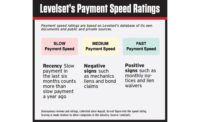When it comes to payment practice transparency, the U.S. is currently in second place to the UK.
In the UK, a public law that took effect two years ago requires big companies in all industries to file reports on their own payment performance. Build UK, a contractor’s association, publishes its members’ performances to “help the construction supply chain to make more informed decisions and drive good practice.” UK construction media regularly report on contractors that slip in the ratings. And tough new rules took effect in September requiring all government suppliers to pay 95% of their invoices within 60 days or run the risk of losing out on major government contracts.
And now that a privately compiled ratings system has been launched, subcontractors and financial experts see potential benefits and have advice about what they consider fair in labeling a company as a fast, medium or slow payer.
Until last month, nothing like the transparency in the UK existed in the U.S. And now that a privately compiled ratings system has been launched, subcontractors and financial experts see potential benefits. They also have advice about what they consider fair in labeling a company as a fast, medium or slow payer.
In January, Levelset, a firm that provides services to help manage and expedite payment through cloud-based software, unveiled the new platform. In addition to rating contractors, it allows companies to post review comments describing their experiences and offering advice to others.
The payment speed score is based on past-payment history compared to other construction contractors. One part is based on the type of slow or nonpayment documents—lien notices, liens or waivers—sent or filed in courts or public records. Another is the total number of documents exchanged. Still another factor in the score is whether the contractor has previously been associated with slow or nonpayment.
The final score also takes into account the recency of detected payment issues.
Levelset CEO Scott Wolfe Jr. said the rating method is transparent and clearly spelled out on the website.
ENR conducted a quick, informal review of 23 companies and related entities profiled on Levelset that are among the top 20 on ENR's current Top 400 Contractors list. Of those, 14 are rated as slow payers, two as fast and seven as medium.
Most of the ratings are positive, however, Wolfe reports.
Levelset calculates a "payment NPS" score, a variation of the net promoter score widely used by businesses to gauge customer satisfaction. The range can be wide but anything over zero is considered good, with 50 and 100 being very good.
Wolfe says his company asks users to rate their payment experience with the general contractor on a scale of 1-10. Some 3,100 of the 7,200 ratings collected gave the general contract a 10/10, and the total Payment Net Positive Score—promoters minus detractors—across all general contactors is 15. "This is fairly positive," says Wolfe.
Some construction pros are optimistic about Levelset’s potential. Richard Bright, chief operating officer of the American Subcontractors Association, sees the upside.
“We believe in payment transparency and prompt payment!” Bright says, echoing one of his organization’s common talking points.
“It could improve behavior,” agrees Courtney N. Little, owner of Little Rock, Ark.-based ACE Glass. “This website opens up the transparency [in the payment process] a bit more—you can research the players on a project ahead of time.”
Assuring Accuracy and Fairness
The longer the time period covered and greater the number of projects, the better, says John Zander, a Chicago consultant who advises banks on construction projects. “This would avoid the problematic cases from distorting the data."
Wolfe says his company’s system has 15,000 users, 8,700 published contractor profiles and 1,100 reviews by 700 subcontractors. In the last year the company’s database collected information on 1 million projects, he adds.
Little also allows that Levelset’s system could be used by an owner in unexpected ways. “Especially if an owner says: ‘Why are you taking 90 days to pay subcontractors? I paid you in 10 days.’”
“I have seen a backlog of change orders which were disputed by the owner become the cause of a serious delay in progress payments,” says Zander. The three most serious of these examples were a result of the owner’s business problems unrelated to the actual change orders, too.
“The effect of delayed change orders in the construction industry can quickly distort the smooth flow of progress, the construction schedule and the payment schedule as well," says Zander. "Data on these cases would unfairly label the prime contractor as a slow payer when the behavior of the owner was the direct cause of the problem.”
On this point, whether owner behavior should remove some of the obligations of the general contractor, Wolfe is steadfast.
“Construction payment speeds are unacceptably slow,” he said in an email. “While there may be many circumstances folding into slow payment problems, the fact remains that the construction industry is the slowest industry on the planet at making payments (see PWC global working capital studies), and it stresses contractors and the industry as a whole."
“It is the general contractor's job to administer payments to subcontractors on jobs, and it is not unfair to examine how good or bad they are at that job.”
He points to the UK’s government-run system, based on compulsory reports submitted yearly by companies with detailed summaries of their payment records.
And, Wolfe notes, one recent report in the Construction Enquirer states that GC payment speeds have increased by nine days in the latest cycle.
And, as any company waiting eagerly for payment would agree, that is progress.




Post a comment to this article
Report Abusive Comment